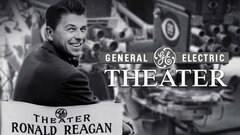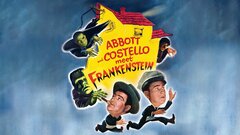One-half of the popular American comedy team Abbott and Costello, Lou Costello was beloved by millions as the hapless, good-natured sap whose fireplug physique and manic energy hilariously played off Bud Abbott's fast-talking wise guy persona. Costello's career in vaudeville took off only after his pairing with Abbott, a fellow performer and talent promoter.
Growing recognition on the stages of New York in the 1930s eventually led to a guest stint on a widely-heard national radio program, followed by their first film as a team, "One Night in the Tropics" (1940). With the massive success of their sophomore effort, "Buck Privates" (1941), Costello and his partner became two of the biggest movie stars of the wartime era.
More hit films like "Pardon My Sarong" (1942), "In Society" (1944) and "The Naughty Nineties" (1945), combined with a popular radio program of their own, kept them at the top of the entertainment heap.
The comedy-monster mash-up "Abbott and Costello meet Frankenstein" (1948) marked the beginning of their "Abbott and Costello Meet " series of comedies.
---
Born Louis Francis Cristillo on March 6, 1906 in Paterson, NJ to parents Helen and Sebastian Cristillo, "Lou," although a precocious prankster at a young age, initially focused on athletics. Despite his lack of height, he was an accomplished basketball player, known for his skill at the free throw, as well as a formidable boxer.
Sometime after graduating high school, he accepted the fact that a sports career was not in the cards for him and changed his goals accordingly. Having recently christened himself with the stage name "Lou Costello," he arrived in Hollywood in 1927 with little money and no place to live.
---
There was a modicum of work to be had, which included stints as an extra in such films as the Laurel & Hardy short "The Battle of the Century" (1927), and a job as a stuntman in the gold rush tale "The Trail of the '98" (1928). None of it, however, was enough to make a living, much less make Costello a star.
Disappointed and nearly broke, he hitchhiked his way back to Paterson, where along the way he began performing on the vaudeville circuit, eventually settling into a modest routine back in the New Jersey-New York area. It was during this period that Costello married Anne Battler, a burlesque dancer he had met on the circuit.
Around the same time, the young comedian crossed paths with veteran vaudeville producer-performer Bud Abbott, and after several onstage collaborations, Abbott and Costello officially became a comedy duo in 1936.
---
Costello and his new straight man gradually began to make a name for themselves as they performed their act at various burlesque shows, vaudeville theaters, and movie house venues. After being signed to the William Morris Agency, Costello and his collaborator gained national exposure when they became featured performers on the popular weekly radio program "The Kate Smith Show" in 1938.
The following year - during which time they also appeared in the Broadway revue "The Streets of Paris" - the funnymen were signed by Universal Pictures, allowing Costello to make his West Coast return under greatly improved circumstances. The comedy team of Abbott and Costello made their feature film debut in "One Night in the Topics" (1940).
---
Although cast in supporting roles, the duo virtually stole the show in the lighthearted comedy, giving audiences an abbreviated version of their famous "Who's on First?" bit, a word-play routine already made popular on the Kate Smith radio program. After renegotiating a long-term contract with Universal, Costello and his partner next appeared onscreen as the stars of "Buck Privates" (1941), a boot-camp comedy released prior to America's entry into World War II.
The first of three films in which the team would co-star alongside the Andrews Sisters, it not only beat "Citizen Kane" (1941) at the box office, but its famous "drill routine" was later notoriously used by the Japanese as wartime propaganda in an illustration of the "ineptitude" of the average U.S. soldier.
---
The huge success of "Buck Privates" made movie stars of Costello and Abbott, and the pair wasted no time getting back into the studio for a string of hits, beginning with "In the Navy" (1941), "Hold That Ghost" (1941), and "Pardon My Sarong" (1942). The following year, the hugely popular duo was given a radio show of their own with "The Abbott and Costello Show," which aired for nearly a decade.
Amidst his enviable professional success, the portly comedian also experienced more than his share of personal tragedy. In November 1943, after recuperating from a bout of rheumatic fever - a prolonged illness that would have lasting, detrimental effects on his health - Costello was given the horrible news that his infant son, Lou, Jr., had accidentally drowned in the family pool.
---
Having just arrived at the NBC studios to perform his weekly radio program that night, Costello insisted on performing as scheduled, telling producers "Wherever he is tonight, I want him to hear me." The age old showbiz axiom of "the show must go on," never held such stoic integrity.
In spite of such heartbreaking events, the streak of hit films continued with fun-loving romps like "It Ain't Hay" (1943), "In Society" (1944), and "Here Come the Co-Eds" (1945). In the best of these films, the boys played good-natured, bumbling schemers who experience changes of heart and/or fortune after being caught up in circumstances beyond their control.
---
At the top of the box office heap throughout World War II, America could not get enough of Costello and his cohort. They even revived their old "Who's on First?" routine with a lengthier, unabridged version for the film "The Naughty Nineties" (1945). On the flip side of that equation, when they attempted to divert from the established pattern of their previous efforts, as they did in "Little Giant" (1945) and "The Time of Their Lives" (1945), which gave each player more individual storylines and injected a touch of drama into the proceedings, moviegoers were less enthusiastic.
In their more appreciated vehicles, the pair cavorted and double-talked their way through enjoyable frolics such as "Buck Privates Come Home" (1947) and "Mexican Hayride" (1948).
---
However, a slight change of trajectory in Costello's career came with the inevitable effects of over-exposure, and a reliance upon an initially winning, but eventually lazy formula struck upon by the studio. At first, "Abbott and Costello Meet Frankenstein" (1948) served as a wacky hybrid vehicle in which Universal could get additional mileage out of its stable of classic movie monsters.
And although audiences initially howled at the hilarious antics of Bud and Lou avoiding the clutches of Frankenstein's Monster (Glenn Strange), Dracula (Bèla Lugosi) and the Wolf Man (Lon Chaney, Jr.), the shtick soon grew stale with subsequent retreads, including "Abbott and Costello Meet The Invisible Man" (1951) and "Abbott and Costello Go to Mars" (1953), to name but a few.
---
That was not to say that Abbott and Costello were no longer popular. Far from it, the pair found a highly receptive audience on television, where, in addition to their films being rerun, they were also given a half-hour comedy program of their own: "The Abbott and Costello Show" (syndicated, 1952-54).
Nonetheless, there were other aspiring successors to the comedy team throne - primarily Dean Martin and Jerry Lewis - and by the time they released the last of their big screen efforts, "Abbott and Costello Meet the Mummy" (1955) and "Dance with Me, Henry" (1956), they were as tired of each other as it seemed America had become with their act.
---
Even though their relationship had been badly strained by a bitter disagreement, the two were tearfully reunited on a 1956 segment of "This is Your Life" (NBC, 1952-1961). Shortly thereafter, the team of Abbott and Costello officially called it quits in 1957. Both Costello and his former partner had run afoul with the IRS, forcing him to sell property and certain film rights, as well as take on jobs performing stand-up comedy and reworking old routines - sans Abbott - on TV programs like "The Steve Allen Show" (NBC, 1956-1960).
Possibly weakened by his bout of rheumatic fever more than a decade earlier, Lou Costello died of a heart attack on March 3, 1959, mere days before his 53rd birthday. His final movie, and the only one in which he starred without Abbott, "The 30-Foot Bride of Candy Rock" (1959), was released in August of that year.
---
By Bryce Coleman
































































![JACK AND THE BEANSTALK, Bud Abbott, Lou Costello, [Abbott & Costello], Shaye Cogan, James Alexander, 1952](https://media.baselineresearch.com/images/429337/429337_small.jpg)

































![ABBOTT & COSTELLO GO TO MARS, Bud Abbott, Mari Blanchard, Lou Costello [Abbott & Costello], 1953](https://media.baselineresearch.com/images/427023/427023_small.jpg)








![AFRICA SCREAMS, Bud Abbott, Lou Costello [Abbott and Costello], 1949](https://media.baselineresearch.com/images/426682/426682_small.jpg)




![BUCK PRIVATES COME HOME, Lou Costello, Bud Abbott [Abbott and Costello], 1947](https://media.baselineresearch.com/images/422400/422400_small.jpg)
![BUCK PRIVATES COME HOME, Lou Costello, Bud Abbott [Abbott and Costello], 1947](https://media.baselineresearch.com/images/422399/422399_small.jpg)

![COMIN' ROUND THE MOUNTAIN, Bud Abbott, Lou Costello [Abbott and Costello], 1951](https://media.baselineresearch.com/images/420050/420050_small.jpg)











![HIT THE ICE, Bud Abbott and Lou Costello [aka Abbott and Costello], 1943](https://media.baselineresearch.com/images/411878/411878_small.jpg)











![HOLD THAT GHOST, Joan Davis, Lou Costello, 1941 [sequence cut from release print]](https://media.baselineresearch.com/images/411185/411185_small.jpg)







![IN SOCIETY, Bud Abbott, Lou Costello [Abbott and Costello], 1944](https://media.baselineresearch.com/images/410192/410192_small.jpg)
![IN SOCIETY, Lou Costello, Tom Dugan, Bud Abbott [Abbott and Costello], 1944](https://media.baselineresearch.com/images/410191/410191_small.jpg)
![IN SOCIETY, Lou Costello, Bud Abbott [Abbott and Costello], 1944](https://media.baselineresearch.com/images/410190/410190_small.jpg)







![IN THE NAVY, Lou Costello, Bud Abbott [Abbott and Costello], 1941](https://media.baselineresearch.com/images/410105/410105_small.jpg)








![JACK AND THE BEANSTALK, Shaye Cogan, James Alexander, William Farnum, Bud Abbott, Lou Costello [Abbott and Costello], 1952](https://media.baselineresearch.com/images/409556/409556_small.jpg)
![JACK AND THE BEANSTALK, Lou Costello, Bud Abbott [Abbott and Costello], 1952](https://media.baselineresearch.com/images/409555/409555_small.jpg)
![JACK AND THE BEANSTALK, Lou Costello, Bud Abbott [Abbott and Costello], 1952](https://media.baselineresearch.com/images/409554/409554_small.jpg)
![JACK AND THE BEANSTALK, Bud Abbott, Lou Costello, Buddy Baer, Dorothy Ford [Abbott and Costello], 1952](https://media.baselineresearch.com/images/409553/409553_small.jpg)
![JACK AND THE BEANSTALK, Bud Abbott, Buddy Baer, Lou Costello [Abbott and Costello], 1952](https://media.baselineresearch.com/images/409552/409552_small.jpg)
![JACK AND THE BEANSTALK, Bud Abbott, Lou Costello [Abbott and Costello], 1952](https://media.baselineresearch.com/images/409551/409551_small.jpg)
![JACK AND THE BEANSTALK, Bud Abbott, Lou Costello [Abbott and Costello], 1952](https://media.baselineresearch.com/images/409550/409550_small.jpg)
![JACK AND THE BEANSTALK, Lou Costello, Bud Abbott, [Abbott & Costello], 1952](https://media.baselineresearch.com/images/409549/409549_small.jpg)
![JACK AND THE BEANSTALK, Lou Costello, Bud Abbott, [Abbott & Costello], 1952](https://media.baselineresearch.com/images/409548/409548_small.jpg)
![JACK AND THE BEANSTALK, Bud Abbott, Lou Costello [Abbott & Costello], 1952](https://media.baselineresearch.com/images/409547/409547_small.jpg)





















![LOST IN A HAREM, Bud Abbott, Marilyn Maxwell, Lou Costello [Abbott & Costello], 1944](https://media.baselineresearch.com/images/406410/406410_small.jpg)
















![THE NAUGHTY NINETIES, Lou Costello, Bud Abbott [Abbott and Costello], 1945](https://media.baselineresearch.com/images/402492/402492_small.jpg)
![THE NAUGHTY NINETIES, Bud Abbott, Lou Costello [Abbott and Costello], 1945](https://media.baselineresearch.com/images/402491/402491_small.jpg)







![ONE NIGHT IN THE TROPICS, Lou Costello, Bud Abbott [aka Abbott and Costello], 1940](https://media.baselineresearch.com/images/401003/401003_small.jpg)
![ONE NIGHT IN THE TROPICS, Bud Abbott and Lou Costello [aka Abbott and Costello], 1940](https://media.baselineresearch.com/images/401002/401002_small.jpg)
![ONE NIGHT IN THE TROPICS, Allan Jones, William Frawley, Lou Costello, Bud Abbott [Abbott and Costello], 1940](https://media.baselineresearch.com/images/401001/401001_small.jpg)
![ONE NIGHT IN THE TROPICS, Bud Abbott, Lou Costello [Abbott & Costello], 1940](https://media.baselineresearch.com/images/401000/401000_small.jpg)

![ONE NIGHT IN THE TROPICS, Lou Costello, Bud Abbott [Abbott and Costello], 1940](https://media.baselineresearch.com/images/400998/400998_small.jpg)











![PARDON MY SARONG, Lou Costello, Bud Abbott [Abbott and Costello], 1942](https://media.baselineresearch.com/images/400052/400052_small.jpg)






![RIDE 'EM COWBOY, Bud Abbott, Lou Costello, [Abbott & Costello], 1942](https://media.baselineresearch.com/images/397339/397339_small.jpg)

![RIDE 'EM COWBOY, Lou Costello, Bud Abbott [Abbott & Costello], 1942](https://media.baselineresearch.com/images/397336/397336_small.jpg)
![RIDE 'EM COWBOY, Lou Costello, Bud Abbott [Abbott & Costello], 1942](https://media.baselineresearch.com/images/397335/397335_small.jpg)
![RIDE 'EM COWBOY, Lou Costello, Bud Abbott [Abbott and Costello], 1942](https://media.baselineresearch.com/images/397334/397334_small.jpg)




































![WHO DONE IT?, Lou Costello, Bud Abbott [Abbott and Costello], 1942](https://media.baselineresearch.com/images/385662/385662_small.jpg)
































































![ABBOTT AND COSTELLO GO TO MARS, Bud Abbott, Lou Costello [Abbott & Costello], 1953](https://media.baselineresearch.com/images/142822/142822_small.jpg)





![ABBOTT AND COSTELLO MEET THE MUMMY, Lou Costello, Eddie Parker, Bud Abbott [Abbott and Costello], 1955](https://media.baselineresearch.com/images/142812/142812_small.jpg)




![ABBOTT AND COSTELLO GO TO MARS, Lou Costello, Bud Abbott [Abbott & Costello], 1953](https://media.baselineresearch.com/images/142807/142807_small.jpg)
![ABBOTT AND COSTELLO GO TO MARS, Lou Costello, Bud Abbott [Abbott & Costello], 1953](https://media.baselineresearch.com/images/142806/142806_small.jpg)







![BUCK PRIVATES, Lou Costello, Maxine Andrews, Patty Andrews, Laverne Andrews [The Andrews Sisters, Abbott and Costello], 1941](https://media.baselineresearch.com/images/136769/136769_small.jpg)
![BUCK PRIVATES, Lou Costello, Bud Abbott [Abbott and Costello], 1941](https://media.baselineresearch.com/images/136768/136768_small.jpg)
![BUCK PRIVATES, Bud Abbott, Lou Costello [Abbott and Costello], 1941](https://media.baselineresearch.com/images/136767/136767_small.jpg)









